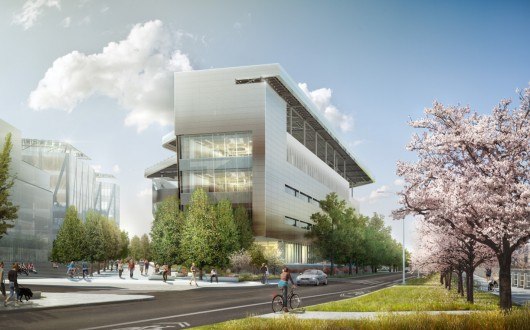Jose Luis Gabriel Cruz reports for Archdaily.
Seven months after the New York City Council approved Cornell University’s two million square foot technology campus in Roosevelt Island, new information has been released — along with a series of new renders. Envisioned as “a campus built for the next century,” Cornell Tech’s first set of buildings has tapped into the talent of some of the most respected architecture firms in the city: Morphosis‘ Pritzker Prize-winning Thom Mayne, Weiss/Manfredi Architecture, Handel Architects, and Skidmore Owings & Merrill.
Three buildings have undergone design development since the approval of SOM’s original master plan: the First Academic Building (Morphosis), the Colocation Building (Weiss/Manfredi Architecture), and the 350-unit residential tower (Handel Architects). These facilities will be connected by a quarter-mile-long ‘tech walk’, designed by James Corner’s Field Operations, which serves as a spine that weaves together the ensemble of buildings whilst functioning as a public pedestrian space that spans the campus’ twelve acres.
The First Academic Building
Sustainable practices are core design principles for the new campus, with design schemes aiming to generate enough energy to run the First Academic Building. Per the latest images, the academic and co-location building’s roofs will both feature solar cells. “It’s literally a lily pad and the building is under this thing,” describes Mayne.
In attempts to create a visual axial connection to the existing Manhattan grid, the First Academic Building’s entry aligns with 57th street from across the East River. “The lack of privacy,” Mayne adds, “is a radical promotion of transparency.”
During a December city council meeting, officials from Cornell, along with all of the architects, discussed the topic of flexibility. The exponential advances in technology and engineering have left many laboratories obsolete, thus requiring building interiors to become easily adaptable.
The Co-Location Building
“This particular building,” explains Marion Weiss, “is an invention,” designed to be a concentrated hothouse of academia and industry. By splitting the building in two and allowing the exterior landscape to seamlessly spill into its core, students and entrepreneurs will share spaces meant to foster interaction with the larger, more public tech community.
The Residential Tower
Handel Architects — the latest recruitment in the roster of architects — is still in the process of designing the residential tower, projected to house students, faculty and staff in a mixture of micro-units, one-, two- and three-bedroom suites. Planned amenities include a gym, bike room, lounge, roof deck, multi-purpose collaboration and media rooms. The images depicting the residential towers do not represent the current or final design.









